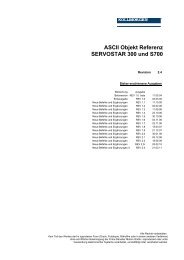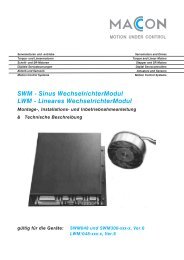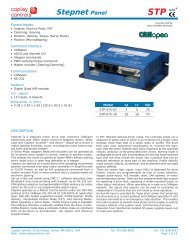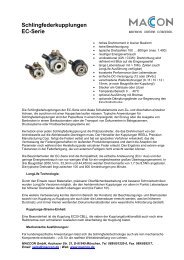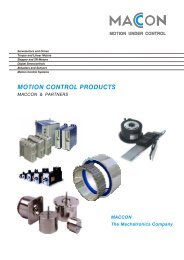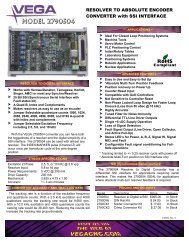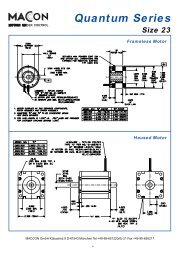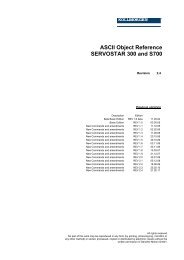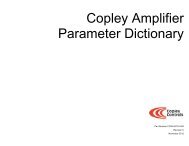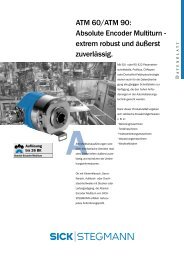CANopen Programmer's Manual - Maccon.de
CANopen Programmer's Manual - Maccon.de
CANopen Programmer's Manual - Maccon.de
You also want an ePaper? Increase the reach of your titles
YUMPU automatically turns print PDFs into web optimized ePapers that Google loves.
9: Cyclic Synchronous Mo<strong>de</strong>s <strong>CANopen</strong> Programmer’s <strong>Manual</strong><br />
Coordinated Motion<br />
Interpolated position mo<strong>de</strong> is used to control multiple coordinated axes or a single axis with the<br />
need for time-interpolation of setpoint data. In interpolated position mo<strong>de</strong>, the trajectory is<br />
calculated by the <strong>CANopen</strong> master and passed to the amplifier’s interpolated position buffer as a<br />
set of points. The amplifier reads the points from the buffer and performs linear or cubic<br />
interpolation between them.<br />
Copley Controls <strong>CANopen</strong> amplifiers support three interpolation sub-mo<strong>de</strong>s: linear interpolation<br />
with constant time, linear interpolation with variable time, and cubic polynomial interpolation, which<br />
is also known as position, velocity, and time (PVT) interpolation. The amplifier can switch between<br />
linear and PVT interpolation on the fly.<br />
Linear Interpolation with a Constant Time<br />
In this mo<strong>de</strong>, trajectory position points are assumed to be spaced at a fixed time interval. The<br />
amplifier drives the axis smoothly between two points within the fixed time.<br />
Linear Interpolation with Variable Time<br />
In this linear interpolation mo<strong>de</strong>, each trajectory segment can have a different time interval.<br />
Cubic Polynomial (PVT) Interpolation<br />
In PVT mo<strong>de</strong>, the <strong>CANopen</strong> master <strong>de</strong>scribes the trajectory points as a position, velocity, and time<br />
until the next point.<br />
Given two such points, the amplifier can interpolate smoothly between them by calculating a cubic<br />
polynomial function, and evaluating it repeatedly until the next point is encountered.<br />
Cubic polynomial interpolation produces much smoother curves than linear interpolation. Thus it<br />
can <strong>de</strong>scribe a complex profile with many fewer reference points. This allows a profile to be<br />
compressed into a small number of reference points which can be sent over the CAN bus using<br />
only a small amount of its total bandwidth.<br />
Standard and Copley Custom Objects for Interpolated Position Mo<strong>de</strong><br />
Copley Controls <strong>CANopen</strong> amplifiers provi<strong>de</strong> two sets of objects for performing IP moves:<br />
The <strong>CANopen</strong> DSP-402 profile standard IP move objects: 0x60C0, 0x60C1, and 0x60C2.<br />
The Copley Controls alternative objects for PVT and linear interpolation with variable time:<br />
0x 2010, 0x 2011, 0x 2012, and 0x 2013. These objects use bandwidth in a more efficient<br />
manner, and feature an integrity counter to i<strong>de</strong>ntify lost packets.<br />
208 Copley Controls




